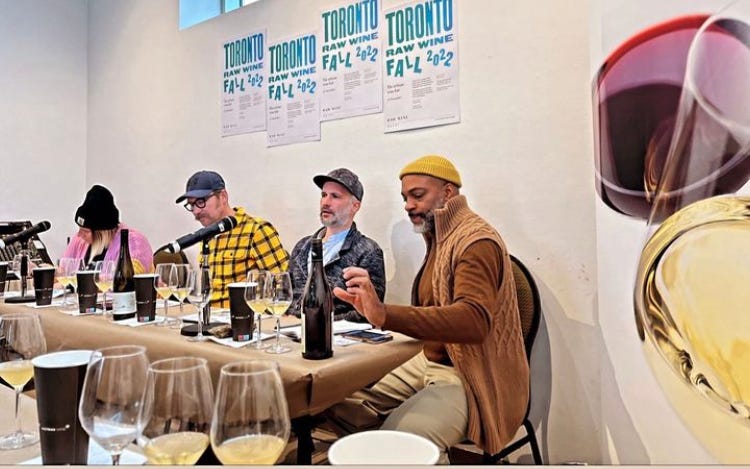RAW WINE Toronto
RAW WINE Fair Arrives in Toronto
RAW WINE is the world’s largest community of low-intervention organic, biodynamic and natural wines. It was started in 2012 by Isabelle Legeron and its natural wine fairs are held in London, Berlin, New York, Montreal (Nov. 19-20), Los Angeles, and for the first time it was held in Toronto on November 16, 2022.
RAW WINE is a community of people who grow/make/sell/drink clean wine cultivated in a clean environment - pure, fermented grape juice with few, if any, additives, grown without the use of synthetic fertilisers, pesticides, herbicides or fungicides, which means plants and soils flourish.
The Toronto fair featured 77 growers and makers from all over the world — Austria, Australia, Canada, Chile, France, Georgia, Germany, Greece, Italy, Netherlands, Portugal, Slovakia, Spain, and the United States — who produce wines that meet the RAW Charter of Quality.
The fair was attended by the growers, their importers, potential importers (there were 10+ growers not yet represented in Ontario), trade professionals, and wine enthusiasts. In addition to getting to meet the growers and taste their wines, the fair also hosted a collection of talks and tastings, and I attended two of the three sessions, written about in today’s newsletter.
Wine Trends Panel: The Importance of Agriculture in Wine
Mark Cuff from Ontario’s The Living Vine, a low-intervention organic, biodynamic and natural wine importer, moderated a panel on wine trends with Alex Bautista, Export Manager at Recaredo & Celler Credo (Spain); Theo Zierock, Winemaker at Foradori (Italy); Arianna Occhipinti, Winemaker and Proprietor at Arianna Occhipinti (Italy); and Harald Thiel, Proprietor of Hidden Bench (Canada).
Some of the recurring themes of the discussion were about the work on the vineyard vs. in the cellar, growing the grapes, and tending to the land and soil. “Ultimately we are farmers, we farm the grapes first,” said Harald, “how can you have a connection to the land if you don't farm the grapes.”
On biodynamic farming — where the idea is to create a self-sustaining eco-system using natural materials, soils, composts, and animals to sustain the vineyard, instead of through the use of chemicals — Alex said the wine industry has a leading role to play, noting that the term itself started entering more mainstream conversations because of wine.
There was also a discussion about the need for more transparency and the importance of describing process — is 100% Pinot Noir enough of a description on a wine label? (No). “Where is information on the soil, where is information on the terroir,” said Arianna, “tell me about the choices the winemaker made.”
Harald added that consumers seem more interested in the process of winemaking rather than the farming, explaining that Hidden Bench has four different Pinot Noirs which all taste different because each has its own terroir (sense of place), though they are made similarly. For the grape growers, it is the agricultural side that is often more interesting.
Austrian Wine Panel: Tasting with the Elements of Nature
Next was a tasting and discussion with Austrian wine growers Maria Koppitsch of Weingut Koppitsch (Burgenland), Leo Uibel of Weinhof Uibel (Weinviertel), and Matthias Hager of Hager Matthias (Kamptal).
The panel was moderated by Christopher Sealy, wine director for Alo and recent recipient of the 2022 Toronto Sommelier Award winner, who led the discussion about the wines and how they interact with the five elements of nature: earth, water, fire, air, and space.
The Urgestein Natural 2020 is a Grüner Veltliner made by Matthias, whose vineyard is in the small wine-growing village Mollands, featuring stony soil, resulting in that classic Grüner minerality. In the UNA 2019, a Frühroter Veltliner made by Leo we tasted elements of the earth with its salinity; we also learned that Frühroter is a red-skinned grape that produces white wine and is grown primarily in the Weinviertel region. On the RÉT, a Zweigelt and St. Laurent blend by Koppitsch, Maria said that the defining element is fire as the vineyard is hot and the soil is sparse, explaining that the challenge is getting the high acidity of the wine in such a hot climate. And the Graue Freyheit 2020 is a blend of Chardonnay, Neuburger, Pinot Blanc, and Pinot Gris made by Weingut Heinrich in Burgenland with two weeks of skin contact, resulting in the energy of a red wine (but it’s orange!), and bottled in a clay flagon (jug).
During the discussion there were comments about how biodynamic farming is the wave of the future in how wines will be made, that a winemaker is not a vigneron (the grape grower), and a recurring theme in both seminars: the differences between wine making (in the cellar) and wine growing (in the vineyard).

Naturally Wine is a Toronto-based weekly newsletter about natural and low-intervention wine, and the producers, importers, and bottle shops behind them.




